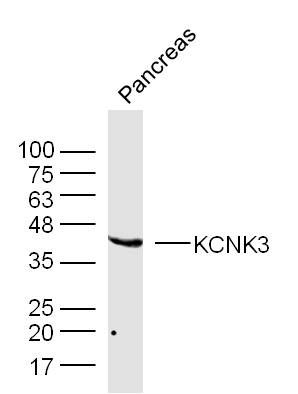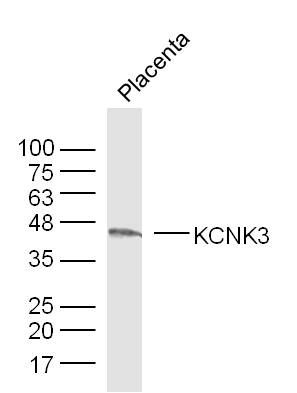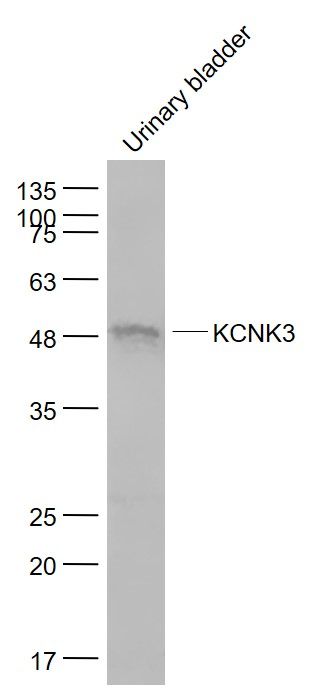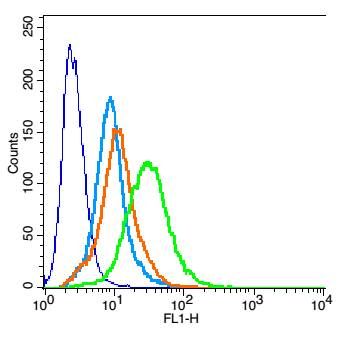| 中文名称 | 酸敏感钾离子通道蛋白3抗体 |
| 别 名 | cTBAK 1; Acid sensitive potassium channel protein TASK 1; Cardiac two pore background K(+) channel; K2p3.1; OAT1; potassium channel, subfamily K, member 3; rTASK; TASK 1; TBAK1; TWIK related acid sensitive K+ channel; Two pore potassium channel KT3.1; KCNK3; TASK; TASK1; PPH4; TASK; TASK-1; TBAK1; KCNK3_HUMAN. |
| 研究领域 | 神经生物学 通道蛋白 细胞膜受体 |
| 抗体来源 | Rabbit |
| 克隆类型 | Polyclonal |
| 交叉反应 | Mouse, Rat, (predicted: Human, Chicken, Dog, Cow, Rabbit, Sheep, ) |
| 产品应用 | WB=1:500-2000 ELISA=1:500-1000 IHC-P=1:100-500 IHC-F=1:100-500 IF=1:100-500 (石蜡切片需做抗原修复) not yet tested in other applications. optimal dilutions/concentrations should be determined by the end user. |
| 分 子 量 | 43kDa |
| 细胞定位 | 细胞膜 |
| 性 状 | Liquid |
| 浓 度 | 1mg/ml |
| 免 疫 原 | KLH conjugated synthetic peptide derived from human KCNK3:51-150/394 |
| 亚 型 | IgG |
| 纯化方法 | affinity purified by Protein A |
| 储 存 液 | 0.01M TBS(pH7.4) with 1% BSA, 0.03% Proclin300 and 50% Glycerol. |
| 保存条件 | Shipped at 4℃. Store at -20 °C for one year. Avoid repeated freeze/thaw cycles. |
| PubMed | PubMed |
| 产品介绍 | This gene encodes a member of the superfamily of potassium channel proteins that contain two pore-forming P domains. The encoded protein is an outwardly rectifying channel that is sensitive to changes in extracellular pH and is inhibited by extracellular acidification. Also referred to as an acid-sensitive potassium channel, it is activated by the anesthetics halothane and isoflurane. Although three transcripts are detected in northern blots, there is currently no sequence available to confirm transcript variants for this gene. [provided by RefSeq, Aug 2008]. Function: pH-dependent, voltage-insensitive, background potassium channel protein. Rectification direction results from potassium ion concentration on either side of the membrane. Acts as an outward rectifier when external potassium concentration is low. When external potassium concentration is high, current is inward. Subcellular Location: Membrane; Multi-pass membrane protein (Potential). Tissue Specificity: Widespread expression in adult. Strongest expression in pancreas and placenta. Lower expression in brain, lung, prostate, heart, kidney, uterus, small intestine and colon. Similarity: Belongs to the two pore domain potassium channel (TC 1.A.1.8) family. SWISS: O14649 Gene ID: 3777 Database links: Entrez Gene: 3777 Human Entrez Gene: 16527 Mouse Entrez Gene: 29553 Rat Omim: 603220 Human SwissProt: O14649 Human SwissProt: Q53SU2 Human SwissProt: O35111 Mouse SwissProt: O54912 Rat Unigene: 645288 Human Unigene: 439936 Mouse Unigene: 15536 Rat Important Note: This product as supplied is intended for research use only, not for use in human, therapeutic or diagnostic applications. |
| 产品图片 |  Sample: Pancreas (Mouse) Lysate at 40 ug Sample: Pancreas (Mouse) Lysate at 40 ugPrimary: Anti-KCNK3 (bs-6674R) at 1/300 dilution Secondary: IRDye800CW Goat Anti-Rabbit IgG at 1/20000 dilution Predicted band size: 43 kD Observed band size: 43 kD  Sample: Placenta (Mouse) Lysate at 40 ug Sample: Placenta (Mouse) Lysate at 40 ugPrimary: Anti-KCNK3 (bs-6674R) at 1/300 dilution Secondary: IRDye800CW Goat Anti-Rabbit IgG at 1/20000 dilution Predicted band size: 43 kD Observed band size: 43 kD  Sample: Sample:Urinary bladder (Mouse) Lysate at 40 ug Primary: Anti- KCNK3 (bs-6674R) at 1/1000 dilution Secondary: IRDye800CW Goat Anti-Rabbit IgG at 1/20000 dilution Predicted band size: 43 kD Observed band size: 49 kD  Blank control(blue): H9C2 (fixed with 2% paraformaldehyde (10 min)) . Blank control(blue): H9C2 (fixed with 2% paraformaldehyde (10 min)) .Primary Antibody:Rabbit Anti- KCNK3 antibody(bs-6674R), Dilution: 6ug in 100 uL 1X PBS containing 0.5% BSA; Isotype Control Antibody: Rabbit IgG(orange) ,used under the same conditions ); Secondary Antibody: Goat anti-rabbit IgG-FITC(white blue), Dilution: 1:200 in 1 X PBS containing 0.5% BSA. |
